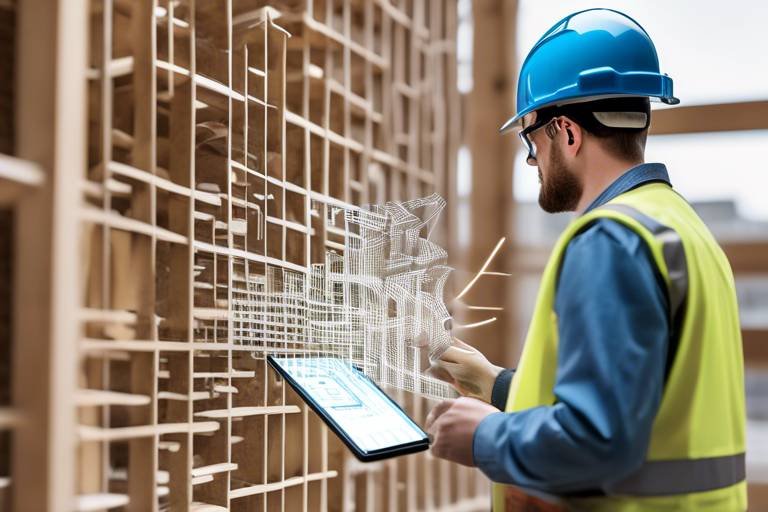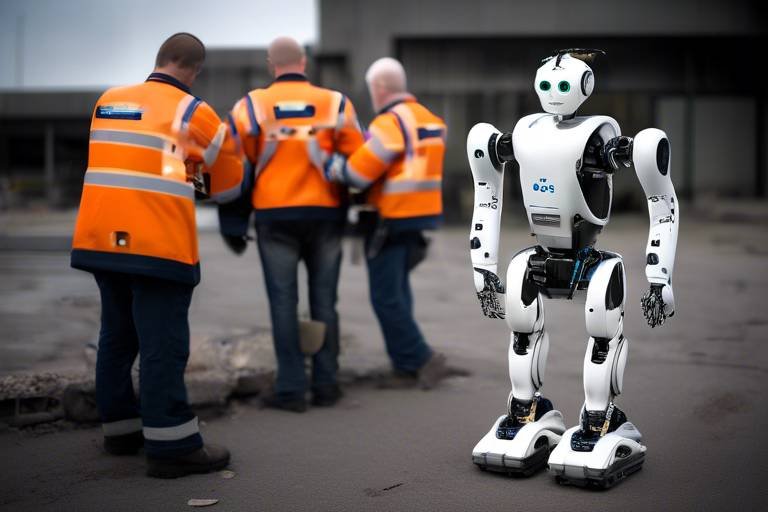The Impact of Technology on Environmental Conservation
In today's world, the intersection of technology and environmental conservation is more vital than ever. As our planet faces unprecedented challenges such as climate change, habitat destruction, and biodiversity loss, innovative technologies are stepping in to revolutionize the way we approach conservation efforts. Imagine a world where drones soar above lush forests, capturing real-time data on wildlife populations, or satellite imagery that unveils the hidden effects of deforestation from space. This is not science fiction; it's the reality we are beginning to embrace. Technology is not just a tool; it's a game-changer that empowers conservationists to monitor ecosystems with unparalleled precision and efficiency.
From artificial intelligence that predicts species behavior to mobile applications that engage communities in conservation efforts, the advancements in technology are reshaping the landscape of environmental protection. The integration of these tools allows for a more proactive approach, enabling conservationists to act swiftly and effectively. With the power of data analytics, we can glean insights into biodiversity and habitat health, which in turn informs targeted interventions. This synergy between technology and conservation is not merely a trend; it's a necessity for the survival of our planet.
As we delve deeper into the topic, we will explore various innovative conservation technologies, the role of data analytics, and how community engagement through technology is transforming conservation practices. Each of these elements plays a crucial role in not only preserving our environment but also in fostering a sustainable future for generations to come. So, let’s embark on this journey to understand how technology is shaping the future of environmental conservation.
Technological advancements are paving the way for groundbreaking conservation methods. Drones, for instance, have emerged as powerful allies in the fight to protect our planet. These unmanned aerial vehicles can cover vast areas in a fraction of the time it would take a human team, capturing high-resolution images and data that were previously unattainable. Imagine being able to monitor endangered species or track illegal logging activities from the sky with pinpoint accuracy. This capability not only enhances our understanding of ecosystems but also equips conservationists with the tools needed to protect them effectively.
Moreover, satellite imagery has become a crucial resource for conservationists. By providing a bird's-eye view of our planet, it allows for the analysis of land use changes, deforestation rates, and habitat degradation over time. This data is essential for assessing the effectiveness of conservation strategies and making informed decisions about resource management. With the ability to visualize ecological patterns and human impacts through Geographic Information Systems (GIS), conservationists can design protected areas that meet the needs of both wildlife and local communities.
Data analytics plays a pivotal role in environmental conservation, offering insights that were once beyond our reach. By analyzing vast amounts of ecological data, scientists can uncover trends in biodiversity and species behavior. This information is invaluable for shaping conservation strategies that are not only effective but also sustainable. For example, understanding the migratory patterns of a species can help in creating protected corridors that ensure their survival.
Remote sensing technology is at the forefront of modern conservation efforts. It allows us to collect data from afar, monitoring changes in land use and assessing the health of ecosystems without disturbing them. This non-invasive approach is essential for understanding the full impact of human activities on the environment.
High-resolution satellite imagery provides conservationists with the ability to track environmental changes over time. From monitoring deforestation to assessing the health of coral reefs, this technology offers a comprehensive view of our planet's health. It enables conservationists to act quickly and effectively, ensuring that interventions are timely and targeted.
Geographic Information Systems (GIS) are powerful tools that allow conservationists to analyze spatial data. By visualizing ecological patterns and human impacts, GIS helps in designing protected areas and managing resources more efficiently. This technology transforms complex data into actionable insights, making it easier to communicate the importance of conservation efforts to stakeholders.
Artificial Intelligence (AI) is making waves in the conservation sector. By analyzing vast datasets, AI can identify patterns and predict trends that inform conservation strategies. For instance, machine learning algorithms can process camera trap images to identify species, monitor population dynamics, and even detect poaching activities. This capability enhances biodiversity protection efforts, allowing for a more proactive approach to conservation.
One of the most exciting developments in conservation technology is the way it fosters community engagement. By empowering local populations to participate in monitoring and protecting their environments, technology enhances the effectiveness of conservation efforts. When communities are involved, they become stewards of their surroundings, leading to more sustainable practices.
Crowdsourcing platforms are revolutionizing the way we gather data on wildlife sightings and environmental changes. By allowing individuals to contribute their observations, these platforms create a collaborative approach to conservation that leverages community knowledge and resources. This not only enriches the data available to scientists but also fosters a sense of ownership and responsibility among local populations.
Mobile applications are another powerful tool in raising awareness about environmental issues. They encourage citizen participation in conservation activities, providing users with tools to report illegal activities and share information about local ecosystems. By making conservation accessible to everyone, these apps play a crucial role in building a more informed and engaged public.
- How does technology help in wildlife conservation? Technology such as drones and satellite imagery allows conservationists to monitor wildlife populations and ecosystems more effectively.
- What role does data analytics play in environmental conservation? Data analytics provides insights into biodiversity and habitat health, enabling targeted interventions and informed decision-making.
- How can communities get involved in conservation efforts? Communities can engage through crowdsourcing platforms and mobile apps that allow them to report sightings and participate in conservation activities.

Innovative Conservation Technologies
In today's world, where environmental challenges loom larger than ever, are stepping up to the plate, transforming the way we approach the protection of our planet. Imagine being able to monitor vast ecosystems from the comfort of your home or utilizing advanced tools that can predict wildlife movements with pinpoint accuracy. This is not science fiction; it’s the reality we live in thanks to cutting-edge technologies like drones and satellite imagery.
Drones, for instance, have become a game-changer in conservation efforts. These flying marvels can cover large areas quickly, capturing high-resolution images and videos of habitats that are otherwise difficult to reach. Whether it's surveying a remote forest or tracking endangered species, drones provide conservationists with real-time data that can significantly enhance their understanding of ecological dynamics. In fact, a recent study showed that drone technology can reduce the time needed for wildlife surveys by up to 80%, allowing researchers to focus their efforts on critical areas that need immediate attention.
Equally impressive is the use of satellite imagery. This technology allows conservationists to monitor environmental changes over time, offering a bird’s-eye view of land use, deforestation rates, and habitat degradation. For example, satellite images can reveal how much forest cover has been lost in a specific area over the years, providing crucial data that can inform conservation strategies. The ability to visualize these changes on a large scale helps in making informed decisions that can lead to effective interventions. As a result, conservationists can prioritize areas that require urgent action, ensuring that resources are allocated where they are needed most.
Moreover, the integration of Geographic Information Systems (GIS) into conservation planning is another leap forward. GIS technology enables conservationists to analyze spatial data, creating detailed maps that visualize ecological patterns and human impacts. By layering different datasets, such as species distribution and habitat quality, conservationists can design protected areas that optimize biodiversity preservation. This technology not only enhances the efficiency of resource management but also aids in engaging stakeholders by providing clear visual representations of conservation goals.
As we delve deeper into the realm of conservation technologies, we cannot overlook the role of artificial intelligence (AI). AI is increasingly being harnessed to sift through vast amounts of ecological data, identifying patterns and predicting trends that are crucial for effective conservation strategies. For example, AI algorithms can analyze camera trap images to identify species presence and behavior, enabling conservationists to monitor biodiversity in real-time. This capability not only enhances our understanding of wildlife but also informs targeted interventions that can help protect vulnerable species.
In summary, the fusion of technology and environmental conservation is creating a new paradigm for protecting our planet. With tools like drones, satellite imagery, GIS, and AI at our disposal, conservationists are better equipped than ever to tackle the pressing challenges of biodiversity loss and habitat degradation. The future of conservation is not just about protecting what we have left; it's about using innovative technologies to restore and enhance the natural world around us.
- What are the main benefits of using drones in conservation?
Drones provide real-time data, cover large areas quickly, and reduce the time needed for wildlife surveys. - How does satellite imagery help in conservation efforts?
Satellite imagery allows for monitoring of environmental changes over time, helping to identify areas that need urgent conservation attention. - What role does AI play in biodiversity conservation?
AI analyzes vast amounts of ecological data to identify patterns and trends, informing conservation strategies and enhancing biodiversity protection efforts.

Data Analytics in Conservation
When it comes to environmental conservation, the role of data analytics cannot be overstated. In a world where information is abundant yet often overwhelming, the ability to sift through vast amounts of ecological data allows conservationists to make informed decisions. Imagine trying to find a needle in a haystack; that’s what it used to be like for scientists trying to understand biodiversity and ecosystem health. But now, with the advancement of data analytics, it’s like having a magnet that pulls those needles right out!
Data analytics provides crucial insights into various aspects of the environment, including species behavior, habitat health, and even the impacts of climate change. By analyzing patterns and trends, conservationists can identify which species are thriving and which are at risk, enabling them to focus their efforts where they are most needed. For example, if data reveals a sudden decline in a particular bird species due to habitat loss, targeted interventions can be implemented swiftly to mitigate the issue.
One of the most exciting aspects of data analytics in conservation is its ability to utilize predictive modeling. This technique allows scientists to forecast future scenarios based on current data, helping them to anticipate potential challenges before they arise. For instance, if data indicates that certain habitats are becoming increasingly fragmented due to urban development, conservationists can proactively work on creating wildlife corridors to facilitate animal movement and preserve biodiversity.
Remote sensing technology is a game-changer in the field of conservation. It allows researchers to collect data from afar, monitoring land use changes, deforestation rates, and habitat degradation without disturbing the ecosystems they study. This technology is essential for assessing the effectiveness of conservation strategies. For example, by comparing satellite images over time, scientists can visually track the progress of reforestation projects or the impacts of illegal logging activities.
Speaking of satellite imagery, this tool provides high-resolution visuals of vast geographical areas, enabling conservationists to track environmental changes over time. Think of it as having a bird’s-eye view of the Earth, where every tree and river is visible. This allows for a comprehensive understanding of how human activities are impacting ecosystems. By analyzing these images, conservationists can identify areas in need of protection or restoration, making their efforts more targeted and effective.
Another powerful tool in the data analytics arsenal is Geographic Information Systems (GIS). GIS helps conservationists analyze spatial data, visualizing ecological patterns and human impacts. With GIS, it’s possible to design protected areas that not only consider the needs of wildlife but also the interests of local communities. By mapping out critical habitats and potential threats, conservationists can devise strategies that balance ecological preservation with human development.
Artificial Intelligence (AI) is making waves in the conservation world by analyzing vast amounts of ecological data quickly and accurately. Imagine having a super-smart assistant that can identify patterns and predict trends in biodiversity. AI algorithms can process data from various sources, such as camera traps and acoustic sensors, to determine species presence and behavior. This not only saves time but also enhances biodiversity protection efforts by ensuring that conservation strategies are based on solid data rather than guesswork.
In conclusion, data analytics is revolutionizing the way we approach environmental conservation. By harnessing the power of technology, conservationists can make informed decisions that lead to more effective and sustainable practices. As we continue to face environmental challenges, the integration of data analytics into conservation efforts will be crucial for protecting our planet’s precious ecosystems.
- What is data analytics in conservation? Data analytics in conservation refers to the use of statistical and computational techniques to analyze ecological data, providing insights that inform conservation strategies.
- How does remote sensing help in conservation? Remote sensing allows conservationists to monitor ecosystems from a distance, tracking changes in land use and habitat conditions without direct interference.
- What role does AI play in biodiversity protection? AI helps analyze large datasets to identify patterns and predict trends, enhancing the effectiveness of conservation efforts.
- Why is GIS important for conservation planning? GIS enables the visualization of spatial data, helping conservationists design protected areas and manage resources efficiently by understanding ecological patterns and human impacts.

Remote Sensing Applications
Remote sensing technology has emerged as a game-changer in the field of environmental conservation. By utilizing satellites and aerial sensors, conservationists can gather critical data without having to physically traverse the often inaccessible terrains of our planet. This ability to collect information from afar not only saves time and resources but also allows for a broader scope of monitoring that was previously unimaginable. Imagine being able to observe vast forests, wetlands, and wildlife habitats from the comfort of your office—this is the power of remote sensing.
One of the most significant applications of remote sensing is in monitoring land use changes. As urbanization and agriculture expand, understanding how these changes impact natural ecosystems is crucial. For instance, remote sensing can reveal patterns of deforestation, enabling conservationists to pinpoint areas that require immediate attention. This proactive approach is essential for preventing habitat loss and ensuring the survival of countless species.
Moreover, remote sensing plays a vital role in assessing the health of various habitats. By analyzing data collected over time, conservationists can identify trends in habitat degradation and restoration. This information is invaluable for making informed decisions about conservation strategies. For example, if a specific area shows signs of declining vegetation health, conservationists can investigate the underlying causes—be it pollution, invasive species, or climate change—and implement targeted interventions.
To illustrate the impact of remote sensing, consider the following table that summarizes its key applications in conservation:
| Application | Description |
|---|---|
| Land Use Monitoring | Tracks changes in land use over time, identifying areas of deforestation and urbanization. |
| Habitat Health Assessment | Evaluates ecosystem health by analyzing vegetation cover and biodiversity indicators. |
| Wildlife Tracking | Monitors animal populations and migratory patterns, aiding in species protection efforts. |
| Climate Change Analysis | Assesses the impact of climate change on ecosystems, helping to develop mitigation strategies. |
In addition to these applications, remote sensing technology is instrumental in disaster response and recovery. When natural disasters strike, such as wildfires, floods, or hurricanes, timely data can guide emergency responses, helping conservationists and local authorities to protect both human lives and natural habitats. This rapid assessment capability can be the difference between effective intervention and catastrophic loss.
Furthermore, the integration of remote sensing with Geographic Information Systems (GIS) enhances the analysis and visualization of spatial data. By layering various data sets, conservationists can create detailed maps that highlight areas of concern, making it easier to communicate findings to stakeholders and the public. This transparency not only fosters trust but also encourages community involvement in conservation efforts.
As we look to the future, the potential of remote sensing in environmental conservation is boundless. With advancements in technology and data analytics, we can expect even more precise and comprehensive monitoring capabilities. The fusion of remote sensing with artificial intelligence, for instance, could lead to predictive models that inform conservation strategies before issues escalate. It’s an exciting time to be involved in conservation, and remote sensing is at the forefront of this evolution.
- What is remote sensing? Remote sensing is the acquisition of information about an object or phenomenon without making physical contact, typically through satellites or aerial sensors.
- How does remote sensing benefit conservation efforts? It allows for efficient monitoring of ecosystems, tracks land use changes, assesses habitat health, and supports disaster response.
- Can remote sensing replace traditional fieldwork? While remote sensing provides valuable data, it complements traditional fieldwork rather than replacing it, as ground-truthing is often necessary for accurate assessments.
- What is the future of remote sensing in conservation? The future looks promising with advancements in technology, including AI, which will enhance data analysis and predictive modeling for better conservation strategies.

Satellite Imagery for Monitoring
Imagine being able to see vast stretches of our planet from the comfort of your home, capturing the intricate dance of nature and human activity all at once. Satellite imagery has transformed this dream into reality, providing conservationists with a powerful tool to monitor environmental changes on a grand scale. With high-resolution images taken from space, conservationists can track everything from deforestation and urban expansion to the subtle shifts in ecosystems that might otherwise go unnoticed.
One of the most significant advantages of satellite imagery is its ability to cover large geographical areas in a relatively short amount of time. This capability allows for ongoing monitoring of critical habitats and endangered species, ensuring that conservationists can respond swiftly to threats. For instance, when a forest is being illegally logged, satellite images can reveal the changes almost in real-time, prompting immediate action from authorities.
Moreover, the data derived from satellite imagery can be analyzed to create detailed maps that illustrate various environmental factors. These maps can show:
- Land use changes: Understanding how land is being utilized helps in assessing the impact on local wildlife.
- Deforestation rates: Tracking how quickly forests are disappearing allows for targeted conservation efforts.
- Habitat degradation: Identifying areas that are suffering from pollution or other forms of degradation can help prioritize restoration efforts.
Additionally, satellite imagery is not just about monitoring; it also plays a crucial role in planning conservation strategies. By visualizing ecological patterns and human impacts, conservationists can design protected areas that are more effective and sustainable. For example, satellite data can help identify corridors that connect fragmented habitats, allowing wildlife to move freely and maintain genetic diversity.
As technology advances, the resolution and quality of satellite images continue to improve, making it easier to detect even the most subtle changes in the environment. This evolution means that conservationists can not only react to changes but also anticipate them, paving the way for proactive conservation efforts. With tools like satellite imagery at their disposal, the future of environmental conservation looks promising, as we strive to protect our planet's precious ecosystems.
1. How often are satellite images updated?
Most satellite imagery providers update their images regularly, with some satellites capturing data daily, while others may do so weekly or monthly, depending on their orbit and mission objectives.
2. Can satellite imagery help in climate change research?
Absolutely! Satellite imagery is vital for tracking climate change indicators such as ice melting, sea-level rise, and changes in vegetation cover, providing essential data for researchers and policymakers.
3. Is satellite imagery accessible to the public?
Yes, many satellite images are available to the public through various platforms, such as Google Earth and NASA's Earth Observing System Data and Information System (EOSDIS).
4. How does satellite imagery contribute to community conservation efforts?
Satellite imagery can empower local communities by providing them with data to monitor their environment, helping them to engage in conservation initiatives and advocate for their ecological needs.

GIS in Conservation Planning
Geographic Information Systems (GIS) have become game-changers in the realm of conservation planning. Imagine trying to solve a complex puzzle where each piece represents different ecological data—this is precisely what GIS does. It allows conservationists to visualize, analyze, and interpret data related to geography, wildlife, and human impact on the environment. By layering various data sets, such as species distribution, land use, and habitat types, GIS enables experts to see the bigger picture and make informed decisions that can significantly enhance conservation efforts.
One of the most significant advantages of GIS is its ability to identify critical habitats and prioritize areas for protection. By analyzing spatial data, conservationists can determine which areas are most vulnerable to threats such as urban development, agriculture, or climate change. This targeted approach ensures that resources are allocated efficiently, maximizing the impact of conservation initiatives. For instance, if a specific region is identified as a biodiversity hotspot, conservationists can focus their efforts on preserving that area, ensuring that endangered species have a safe haven.
Additionally, GIS plays a vital role in the management of protected areas. By providing detailed maps and spatial analysis, conservationists can monitor changes in land use over time and assess the effectiveness of management strategies. For example, if a protected area is experiencing increased human encroachment, GIS can help identify the extent of this impact and inform necessary management actions. This proactive approach is crucial for adapting to ongoing environmental changes and ensuring the long-term success of conservation efforts.
Moreover, GIS facilitates collaboration among various stakeholders, including government agencies, non-profits, and local communities. By sharing GIS data and maps, different organizations can work together towards common conservation goals. This collaboration is essential, as many conservation challenges are complex and require a multi-faceted approach. For instance, when planning a new wildlife corridor, GIS can help different groups visualize potential routes and assess their impacts on both wildlife and human communities.
In conclusion, GIS is an invaluable tool in conservation planning. It not only enhances the ability to make data-driven decisions but also fosters collaboration among various stakeholders. As technology continues to evolve, the integration of GIS into conservation strategies will undoubtedly lead to more effective and sustainable practices, helping to protect our planet for future generations.
- What is GIS?
GIS stands for Geographic Information Systems, a technology used to capture, store, analyze, and manage spatial or geographic data.
- How does GIS help in conservation?
GIS helps in conservation by allowing for the visualization and analysis of ecological data, helping to identify critical habitats and prioritize conservation efforts.
- Can GIS be used by local communities?
Yes, GIS can be utilized by local communities to engage in conservation planning and management, fostering grassroots involvement in environmental protection.
- What are some applications of GIS in conservation?
Applications include habitat mapping, species distribution modeling, land use planning, and monitoring the effectiveness of protected areas.

Artificial Intelligence in Biodiversity
Artificial Intelligence (AI) is making waves in the field of biodiversity conservation, acting like a digital detective that sifts through mountains of ecological data to uncover hidden patterns and insights. Imagine having a super-smart assistant that can analyze data faster than a speeding bullet, allowing conservationists to make informed decisions about protecting our planet's diverse species. With AI, we're not just observing nature; we're actively understanding and predicting how different factors affect biodiversity.
One of the most exciting applications of AI in biodiversity is its ability to process and analyze data from various sources, such as camera traps, acoustic sensors, and satellite imagery. These technologies generate a staggering amount of data, and AI algorithms can quickly identify species, track their movements, and even detect changes in their behavior. For instance, AI can analyze sound recordings from rainforests to identify the presence of specific bird species, which is crucial for monitoring population health and habitat changes.
Furthermore, AI can help predict future trends in biodiversity by analyzing historical data and identifying correlations between environmental factors and species survival. This predictive capability is vital for conservationists as they develop strategies to mitigate threats such as habitat loss, climate change, and invasive species. By understanding potential future scenarios, conservationists can implement proactive measures rather than just reactive ones.
To illustrate the impact of AI on biodiversity, consider the following examples:
- Species Identification: AI-powered image recognition tools can automatically identify and classify species from photographs, making it easier for researchers to catalog biodiversity without extensive manual labor.
- Habitat Monitoring: AI can analyze satellite images to detect changes in land use or habitat degradation, providing real-time insights that inform conservation strategies.
- Predictive Modeling: By utilizing AI algorithms, scientists can simulate various environmental scenarios and their potential impacts on different species, helping to prioritize conservation efforts.
Incorporating AI into biodiversity conservation not only enhances the efficiency of data analysis but also democratizes access to information. With open-source AI tools, even small conservation groups can leverage advanced technology to improve their efforts. This means that grassroots organizations, often the backbone of local conservation initiatives, can now utilize sophisticated tools that were once only available to large research institutions.
As we continue to harness the power of AI in biodiversity, it's essential to consider ethical implications and ensure that these technologies are used responsibly. Conservationists must balance technological advancement with the need for sustainable practices that respect local communities and ecosystems. By fostering collaboration between technology experts and conservationists, we can create innovative solutions that not only protect biodiversity but also empower local populations.
In conclusion, AI is revolutionizing the way we approach biodiversity conservation. By providing powerful tools for data analysis, predictive modeling, and community engagement, AI is helping to create a more sustainable future for our planet's diverse species. Embracing these technologies will not only enhance our understanding of biodiversity but also empower us to take meaningful action in protecting the natural world.
- How does AI help in species identification? AI uses image recognition algorithms to analyze photographs and automatically identify different species, streamlining the cataloging process.
- Can AI predict future changes in biodiversity? Yes, AI can analyze historical data to identify trends and predict how environmental changes may impact various species.
- Is AI accessible for small conservation organizations? Absolutely! Many open-source AI tools are available, allowing smaller organizations to utilize advanced technology in their conservation efforts.

Community Engagement through Technology
In today's fast-paced world, technology is not just a tool for businesses and governments; it's a powerful ally in the fight for environmental conservation. The ability to engage communities through technology has transformed the way we approach conservation efforts. Imagine a world where local residents, equipped with smartphones and apps, actively participate in monitoring their surroundings. This is not a distant dream; it's happening right now! Technology fosters a sense of ownership and responsibility among community members, making conservation a collective effort rather than a top-down imposition.
One of the most exciting developments in this arena is the rise of crowdsourcing conservation efforts. Platforms that enable individuals to report wildlife sightings, track environmental changes, and share observations have revolutionized data collection. These platforms harness the collective knowledge of communities, allowing conservationists to tap into a wealth of information that would otherwise be difficult to obtain. For example, a simple app can allow users to log their sightings of endangered species, contributing to a larger database that informs conservation strategies.
Moreover, mobile applications play a crucial role in raising awareness about environmental issues. They not only provide users with the latest information on local ecosystems but also offer tools for reporting illegal activities, such as poaching or illegal dumping. By empowering citizens with the right tools, technology creates a network of vigilant protectors for our planet. This grassroots involvement can lead to significant changes; when people feel they can make a difference, they are more likely to take action.
To illustrate the impact of technology in community engagement, consider the following table that outlines key benefits:
| Benefit | Description |
|---|---|
| Increased Awareness | Technology facilitates the dissemination of information, helping communities understand the importance of conservation. |
| Real-time Reporting | Mobile apps allow for immediate reporting of environmental issues, leading to quicker responses. |
| Data Collection | Crowdsourced data provides valuable insights that can guide conservation strategies. |
| Community Empowerment | Engaging local populations fosters a sense of ownership and responsibility towards their environment. |
As we continue to explore the intersection of technology and conservation, it's clear that community engagement is vital for the success of any environmental initiative. The more involved communities are, the more effective conservation efforts become. Technology acts as a bridge, connecting individuals with the larger goals of sustainability and ecological protection. So, next time you see a mobile app dedicated to wildlife conservation or a social media campaign promoting local ecosystems, remember that these are not just trends; they are essential tools in the fight for our planet's future.
- How can I get involved in community conservation efforts?
Look for local organizations that focus on environmental issues and see if they have volunteer opportunities or community events. - What technologies are most effective for conservation?
Drones, mobile apps, and GIS technology are among the most effective tools currently used in conservation efforts. - Can I contribute to conservation efforts without being a scientist?
Absolutely! Citizen science initiatives welcome contributions from everyone, regardless of their background. - What role do social media platforms play in conservation?
Social media helps raise awareness, share information, and mobilize community action for environmental causes.

Crowdsourcing Conservation Efforts
Crowdsourcing has emerged as a powerful tool in the realm of environmental conservation, allowing individuals from all walks of life to contribute to the protection of our planet. Imagine a world where every person, armed with just a smartphone, can make a significant impact on conservation efforts. This is not just a dream; it is a reality made possible through innovative technology. By harnessing the collective knowledge and resources of communities, conservationists can gather invaluable data that would be impossible to obtain through traditional methods alone.
One of the most exciting aspects of crowdsourcing in conservation is the ability to engage local communities directly. When people are given the tools to monitor their surroundings, they become more invested in the health of their ecosystems. For instance, platforms like iNaturalist allow users to document wildlife sightings and share their findings with scientists. This collaboration not only enriches scientific databases but also fosters a sense of stewardship among participants. Imagine walking through a park and spotting a rare bird; with a few taps on your phone, you can contribute to a global database that helps track species populations and movements.
Moreover, crowdsourcing can amplify conservation messages and mobilize community action. Social media campaigns and apps designed for environmental reporting empower citizens to raise awareness about illegal activities such as poaching and pollution. These platforms often feature user-friendly interfaces that encourage participation, making it easy for anyone to report incidents or share educational content. For example, the app "Wildlife Witness" allows users to report wildlife crime in real-time, creating a more vigilant and informed community.
However, it's important to note that crowdsourcing is not without its challenges. Data quality is a significant concern; not all contributions are accurate or reliable. Therefore, conservation organizations often implement verification processes to ensure the data collected is credible. This may involve cross-referencing user submissions with expert analysis or utilizing machine learning algorithms to filter out noise from genuine insights. By combining community data with scientific expertise, conservationists can create a more comprehensive picture of ecological health.
In summary, crowdsourcing conservation efforts is a revolutionary approach that leverages technology to engage communities, gather critical data, and promote environmental stewardship. As more individuals join this movement, the potential for positive change grows exponentially. Just as a single drop can create ripples in a pond, each contribution matters in the grand scheme of conservation. The future of our planet may well depend on the active participation of its citizens, united by a common goal of protecting the natural world.
- What is crowdsourcing in conservation? Crowdsourcing in conservation refers to the practice of engaging the public to contribute data and observations about wildlife and environmental conditions, enhancing the overall conservation efforts.
- How can I participate in crowdsourcing conservation efforts? You can participate by using mobile apps designed for wildlife reporting, joining community science projects, or engaging in local conservation initiatives.
- What are some examples of crowdsourcing platforms? Examples include iNaturalist, Wildlife Witness, and various social media campaigns focused on environmental issues.
- How is the data collected through crowdsourcing verified? Data verification may involve cross-referencing submissions with expert analysis, utilizing machine learning algorithms, or community review processes to ensure accuracy.

Mobile Apps for Awareness
In today's digital age, mobile applications have become powerful tools for raising awareness about environmental issues and fostering community involvement in conservation efforts. Imagine holding the fate of our planet in your pocket—literally! These apps not only inform users about pressing ecological challenges but also empower them to take action. It's like having a personal environmentalist with you at all times, guiding you through the complexities of nature conservation.
One of the most significant advantages of mobile apps is their ability to reach a vast audience quickly and effectively. Whether you're a nature enthusiast or a casual observer, these applications provide a platform for everyone to engage with and contribute to environmental protection. For instance, apps like iNaturalist allow users to document their wildlife sightings, contributing valuable data to scientific research while simultaneously increasing their understanding of local biodiversity. It's a win-win situation!
Moreover, mobile apps serve as a bridge between individuals and local conservation efforts. They often feature tools for reporting illegal activities, such as poaching or illegal dumping, which can be crucial for protecting vulnerable ecosystems. By making it easy for users to report these issues, the apps create a sense of community responsibility. As people become more aware of their surroundings, they are more likely to take action when they see something amiss.
Another exciting aspect of these applications is their ability to gamify conservation. Many apps incorporate elements of competition and rewards, encouraging users to participate more actively. For example, users might earn points for reporting sightings, participating in clean-up events, or even sharing educational content. This gamification not only makes conservation efforts more engaging but also fosters a sense of camaraderie among users, turning them into a community of eco-warriors.
Here are some notable features of mobile apps that enhance awareness and engagement in environmental conservation:
- Real-time Notifications: Users receive alerts about local conservation events, species sightings, or environmental threats, keeping them informed and engaged.
- Educational Resources: Many apps provide access to articles, videos, and tutorials that educate users about ecosystems, wildlife, and conservation strategies.
- Social Sharing: Users can easily share their findings and experiences on social media, spreading awareness and inspiring others to get involved.
In conclusion, mobile apps are revolutionizing the way we engage with environmental issues. They not only enhance awareness but also empower individuals to take meaningful action in their communities. By leveraging technology, we can inspire a new generation of conservationists who are informed, active, and passionate about protecting our planet. So, the next time you reach for your phone, consider how you can use it to contribute to a healthier Earth!
Q1: How can I find mobile apps focused on environmental conservation?
A1: You can search for environmental conservation apps in your device's app store. Look for keywords like "wildlife conservation," "environmental awareness," or "nature apps." Many organizations also recommend specific apps on their websites.
Q2: Are mobile apps effective in promoting conservation efforts?
A2: Yes, mobile apps have proven to be effective tools for raising awareness and encouraging participation in conservation initiatives. They provide accessible information and foster community engagement, which can lead to positive environmental outcomes.
Q3: Can I contribute to conservation efforts through these apps?
A3: Absolutely! Many apps allow users to report wildlife sightings, participate in citizen science projects, and even volunteer for local conservation events. Your contributions can make a significant difference!
Frequently Asked Questions
- What role does technology play in environmental conservation?
Technology plays a pivotal role in environmental conservation by providing innovative tools and methodologies that enhance monitoring, data collection, and analysis. From drones capturing aerial footage to satellite imagery tracking deforestation, these advancements allow conservationists to make informed decisions and implement effective strategies to protect our planet.
- How can data analytics improve conservation efforts?
Data analytics improves conservation efforts by offering insights into biodiversity, species behavior, and habitat health. By analyzing large datasets, conservationists can identify trends, assess the impact of human activities, and target interventions more effectively. This data-driven approach ensures that resources are allocated where they are needed most, maximizing the impact of conservation initiatives.
- What is remote sensing, and how is it used in conservation?
Remote sensing is a technology that allows conservationists to collect data from a distance, using tools like satellites and aerial imagery. This technology is crucial for monitoring land use changes, deforestation rates, and habitat degradation. By assessing these factors, conservationists can evaluate the effectiveness of their strategies and adapt their approaches to better protect ecosystems.
- Can artificial intelligence help in biodiversity protection?
Absolutely! Artificial Intelligence (AI) is increasingly being used to analyze vast amounts of ecological data. It helps identify patterns, predict trends, and inform conservation strategies. By leveraging AI, conservationists can enhance their efforts in protecting biodiversity and ensuring the sustainability of various species.
- How does community engagement through technology benefit conservation?
Community engagement through technology empowers local populations to take an active role in conservation efforts. By utilizing mobile apps and crowdsourcing platforms, individuals can report wildlife sightings, share information, and participate in monitoring activities. This grassroots involvement not only raises awareness but also strengthens the effectiveness of conservation initiatives.
- What are some examples of mobile apps used for conservation awareness?
There are several mobile apps designed to raise awareness about environmental issues and encourage participation in conservation activities. These apps often provide tools for reporting illegal activities, tracking wildlife sightings, and sharing information about local ecosystems. Some popular examples include iNaturalist, Seek by iNaturalist, and Wildlife Sightings.



















